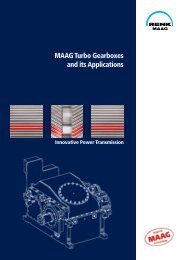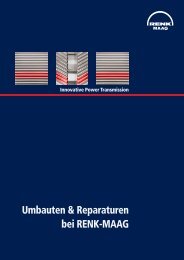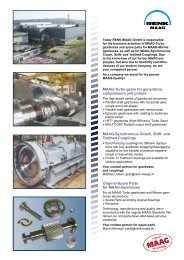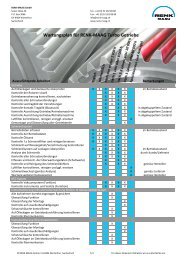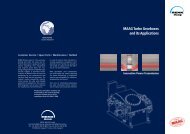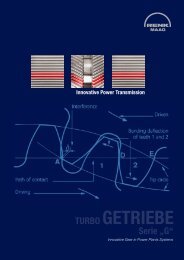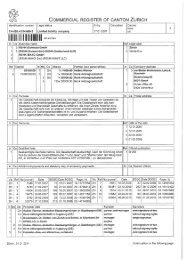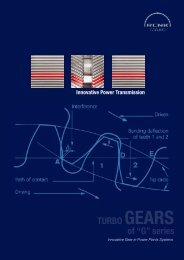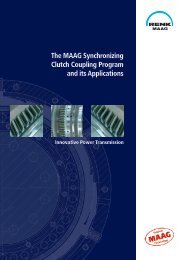The MAAG Synchronizing Clutch Coupling Program and its ...
The MAAG Synchronizing Clutch Coupling Program and its ...
The MAAG Synchronizing Clutch Coupling Program and its ...
You also want an ePaper? Increase the reach of your titles
YUMPU automatically turns print PDFs into web optimized ePapers that Google loves.
<strong>The</strong> <strong>MAAG</strong> <strong>Synchronizing</strong><br />
<strong>Clutch</strong> <strong>Coupling</strong> <strong>Program</strong><br />
<strong>and</strong> <strong>its</strong> Applications<br />
Innovative Power Transmission
2<br />
<strong>The</strong> <strong>MAAG</strong> <strong>Synchronizing</strong> <strong>Clutch</strong> <strong>Coupling</strong> <strong>Program</strong><br />
<strong>and</strong> <strong>its</strong> Applications<br />
In 1960 <strong>MAAG</strong> decided to develop <strong>and</strong><br />
manufacture synchronizing clutch couplings.<br />
After extensive research <strong>and</strong> design<br />
work, including the testing of a proto type<br />
on a special testbed, the first unit was sold<br />
in 1964. Since then, continuous development<br />
of this product has resulted in a<br />
prod uct line that now enables us to offer<br />
a range of different synchronizing clutch<br />
couplings. All types can be supplied with<br />
features tailored to the specific requirements<br />
of the synchronizing clutch coupling<br />
applications.<br />
<strong>Synchronizing</strong> clutch couplings are required<br />
in a wide range of application.<br />
Marine Applications<br />
• combined propulsion systems such as<br />
CODOG, COGOG, CODAG, COGAG,<br />
CODAD, etc.<br />
• efficiency booster drives for diesel<br />
engine propulsion<br />
Power Generation<br />
• generator drives<br />
• peaking power stations<br />
• air storage power stations<br />
Energy Recovery, Combined Cycle<br />
Technologies, Cogeneration <strong>and</strong><br />
others<br />
• connecting exp<strong>and</strong>er turbines to main<br />
drives in petrochemical plants<br />
• blower drives in nuclear power stations<br />
for use during starting sequence<br />
• starting device for gas turbines<br />
• automatic turning gears<br />
<strong>Synchronizing</strong> clutch couplings are couplings<br />
which engage <strong>and</strong> disengage automatically.<br />
<strong>The</strong>y are capable of automatic<br />
engagement at any speed within the<br />
operating range as soon as the driving<br />
machine overruns the driven machine.<br />
Basically the synchronizing clutch coupling<br />
is a disengageable coupling equipped with<br />
a synchronizing mechanism.<br />
<strong>The</strong> synchronizing clutch coupling consists<br />
of two main elements:<br />
A) <strong>The</strong> gear coupling part for the power<br />
transmission. This is the same as in a<br />
st<strong>and</strong>ard tooth coupling, i. e. the external<br />
coupling teeth are hardened <strong>and</strong> ground<br />
with longitudinal corrections allowing for<br />
angular misalignment.<br />
B) <strong>The</strong> synchronizing mechanism detects<br />
synchronism of both shafts <strong>and</strong> initiates<br />
subsequently the engagement. This synchronizing<br />
mechanism is an assembly consisting<br />
mainly of a number of pawls <strong>and</strong> a<br />
multiple notched ratchet wheel. Together<br />
they act as a free wheel drive.
Today, RENK<strong>MAAG</strong> offers three main<br />
sychronizing clutch coupling lines.<br />
Type MS Type DS Type HS<br />
• <strong>The</strong> clutch engages<br />
automatically when<br />
the input shaft<br />
overruns the output<br />
shaft.<br />
• Positive torque can<br />
be transmitted.<br />
• <strong>The</strong> clutch disengages<br />
automatically<br />
when the torque<br />
becomes negative.<br />
• After the «ENGAGE»<br />
comm<strong>and</strong> is given,<br />
the clutch engages<br />
automatically when<br />
the two shafts overrun<br />
each other, irrespective<br />
of direction.<br />
• Positive <strong>and</strong> negative<br />
torque can be transmitted.<br />
• After the «FREE<br />
WHEEL» comm<strong>and</strong> is<br />
given, the clutch disengagesautomatically<br />
when the torque<br />
becomes negative.<br />
Once disengaged, the<br />
two shafts are free to<br />
overrun each other.<br />
• <strong>The</strong> clutch engages<br />
automatically when<br />
the input shaft<br />
overruns the output<br />
shaft.<br />
• Positive <strong>and</strong> negative<br />
torque can be transmitted.<br />
• <strong>The</strong> clutch disengages<br />
only upon<br />
comm<strong>and</strong>.<br />
1<br />
<strong>The</strong> synchronizing mechanism is designed for unlimited operation of the clutch in<br />
disengaged position at any speed difference between the input <strong>and</strong> output shafts.<br />
2<br />
<strong>The</strong> synchronizing mechanism is of relatively light but still robust construction.<br />
<strong>The</strong>refore, high angular accelerations at engagement are permissible.<br />
3<br />
<strong>The</strong> synchronizing mechanism plays no part whatever in power transmission. It is<br />
simple, compact <strong>and</strong> incorporated into the coupling sleeve, suitable for high speed<br />
operation.<br />
4<br />
Torque transmission is the same as in st<strong>and</strong>ard toothed couplings, combining<br />
torsional rigidity with axial <strong>and</strong> angular flexibility.<br />
5<br />
Suitable for transmitting practically any torque at any speed for which toothed<br />
couplings can be employed.<br />
6<br />
Angular <strong>and</strong> parallel misalignment of the shafts is easily accommodated by the<br />
coupling components.<br />
3
4<br />
Each synchronizing clutch coupling can<br />
also be supplied with a variety of distinctive<br />
options. <strong>The</strong> diagram below gives some ex<br />
MS-R MS-S<br />
amples of possible features combinations<br />
for two of the designs, Type MS <strong>and</strong> Type<br />
HS.<br />
<strong>Synchronizing</strong> <strong>Clutch</strong> <strong>Coupling</strong><br />
MS<br />
Basic Design<br />
DS<br />
Additional Features<br />
MS-H HS-H<br />
J<br />
X<br />
F<br />
Q<br />
E<br />
T<br />
A<br />
HS<br />
HS-N<br />
R: locking mechanism<br />
S: rigid when engaged<br />
H: integrated fluid coupling<br />
for startup<br />
N: engagement at low speed<br />
J: electrical insulation<br />
X: limited end float<br />
F: isolating device (pawl free)<br />
Q: quill shaft arrangement<br />
E: encased<br />
T: for turning gears<br />
A: for starter drives
Applications for<br />
<strong>MAAG</strong> <strong>Synchronizing</strong> <strong>Clutch</strong> <strong>Coupling</strong>s<br />
In light of the information on page 4, the<br />
following information can be ob tained<br />
from the type designation of a particular<br />
synchronizing clutch coupling:<br />
basic design:<br />
M<br />
H<br />
S<br />
S<br />
M = mechanical automatic<br />
disengagement<br />
H = hydraulic disengagement<br />
S = synchronizing<br />
clutch coupling<br />
coupling size<br />
26<br />
60 / 7<br />
R<br />
H<br />
...<br />
additional features<br />
(see legend on the left)<br />
...<br />
...<br />
...<br />
coupling / synchronizer size<br />
5
6<br />
Marine Applications<br />
Installation of a <strong>MAAG</strong> synchronizing clutch<br />
coupling type HS40F in a <strong>MAAG</strong> marine<br />
gearbox type DTA260W CODOG.<br />
<strong>The</strong> synchronizing clutch coupling is<br />
mounted between the gas turbine <strong>and</strong> the<br />
first reduction pinion shaft, whereas the<br />
diesel engine is connected to the gearbox<br />
through a friction clutch.<br />
At cruising speed, the diesel engine is<br />
clutched to the gearbox <strong>and</strong> the gas turbine<br />
is stationary with the synchronizing<br />
clutch coupling disengaged. If maximum<br />
speed is dem<strong>and</strong>ed the gas turbine will<br />
be started <strong>and</strong> accelerated. When the turbine<br />
shaft overruns the primary pinion, the<br />
clutch engages. <strong>The</strong> ship’s propulsion power<br />
is now delivered by the gas turbine, the<br />
Isolating device (manually operated)<br />
<strong>Clutch</strong> coupling<br />
Output (pinion shaft) Input (gas turbine)<br />
diesel engine is disconnected <strong>and</strong> the gas<br />
turbine accelerates further up to full speed.<br />
When changing back to cruising speed,<br />
the gas turbine will be decelerated, the<br />
diesel engine started <strong>and</strong> clutched to the<br />
gearbox as soon as the speed is within the<br />
operating range of the diesel engine. After<br />
the load has been transferred from the gas<br />
turbine to the diesel engine, the disengage<br />
signal is given to the synchronizing clutch<br />
coupling, the clutch disengages <strong>and</strong> the<br />
gas turbine, disconnected from the main<br />
gear, runs down to st<strong>and</strong>still.<br />
Diesel<br />
engine<br />
Friction<br />
clutch<br />
Gearbox<br />
<strong>Synchronizing</strong><br />
clutch coupling<br />
type HS40F<br />
Gas turbine
Typical arrangement of two synchronizing<br />
clutch couplings in CODOG marine gearbox.<br />
<strong>The</strong> type MS36RF which connect/disconnect<br />
the gas turbine from the main gear<br />
train is equipped with a locking mechanism<br />
<strong>and</strong> an isolating device (pawl free<br />
posi tion). <strong>The</strong> other type MS36RQ to<br />
connect/disconnect the diesel engine from<br />
the main drive is of the quill shaft mounted<br />
design.<br />
<strong>The</strong> operating characteristics of this installation<br />
are basically the same as the previous<br />
application. However, because type<br />
MS clutches are installed no disengaging<br />
signal is needed to disengage the clutch.<br />
After the power transfer has been accom<br />
Diesel<br />
engine<br />
Gearbox<br />
Hydraulic<br />
coupling<br />
<strong>Synchronizing</strong><br />
clutch coupling<br />
type MS36RQ<br />
<strong>Synchronizing</strong><br />
clutch coupling<br />
type MS36RF<br />
Gas turbine<br />
plished, the changeover is achieved by reducing<br />
the speed of the driver to be shut<br />
down.<br />
A clutch is required in the diesel engine<br />
drive train because the output members of<br />
the hydraulic coupling cannot sustain the<br />
higher speed in propulsion mode.<br />
In the installation described here, each of<br />
the clutches is equipped with a locking<br />
mech anism. Prior to a propulsion mode<br />
changeover the clutch to be disengaged<br />
has to be unlocked. This is initiated by an<br />
electric signal.<br />
Diesel clutch in disengaged (quill shaft mounted) position<br />
Output<br />
(pinion shaft)<br />
Output<br />
(pinion shaft)<br />
Spool<br />
piece<br />
Input<br />
(diesel engine)<br />
<strong>Coupling</strong><br />
sleeve<br />
Turbine clutch in disengaged position<br />
Input<br />
(gas turbine)<br />
Lube<br />
oil feed<br />
7
8<br />
<strong>The</strong> diagram below shows an arrangement<br />
for a CODAG marine propulsion system.<br />
This system requires three synchronizing<br />
clutches, 2 MS types <strong>and</strong> 1 DS type. <strong>The</strong> arrangement<br />
combines a gas turbine with a<br />
diesel engine.<br />
Normally, a speed change gearset (gearbox<br />
A) is required at the cruise diesel engine<br />
when the booster is added to the drive<br />
system to be operated in combined mode<br />
(CODAG). This is necessary to prevent the<br />
diesel engine overspeeding.<br />
<strong>The</strong> gas turbine booster drive is clutched<br />
to the main gearbox by an MS clutch (B).<br />
<strong>The</strong> + sign indicates that the clutch engages<br />
automatically when the turbine input speed<br />
overruns the input pinion speed.<br />
View of DS synchronizing clutch coupling<br />
In cruising mode when the Diesel only is driving<br />
clutch C <strong>and</strong> A (+ end) are engaged <strong>and</strong> locked,<br />
clutch B <strong>and</strong> A ( end) are disengaged. Torque is<br />
transmitted by clutch C only.<br />
In GT only driving mode clutch B <strong>and</strong> A ( end)<br />
are engaged <strong>and</strong> locked, clutch C <strong>and</strong> A (+ end)<br />
are disengaged. Torque is transmitted by clutch B<br />
only. Gearbox A is at st<strong>and</strong>still.<br />
In CODAG mode, Diesel <strong>and</strong> GT driving, clutch A<br />
(+ <strong>and</strong> – end) <strong>and</strong> B are engaged <strong>and</strong> locked,<br />
clutch C is disengaged.<br />
<strong>The</strong> diesel engine cruise drive is clutched to<br />
the main gearbox by an MS clutch (C). <strong>The</strong><br />
+ sign again indicates the same functions<br />
as above.<br />
For both drivers to operate together, it is necessary<br />
to transmit the power of the diesel<br />
engine through a ratio matching gearset,<br />
(gearbox A) such that the engine can operate<br />
in <strong>its</strong> most efficient operating condition.<br />
This requires a DS clutch (A) which is freewheeling<br />
in either gas turbine only mode or<br />
diesel engine only mode, <strong>and</strong> which is engaged<br />
<strong>and</strong> locked (both the + <strong>and</strong> – ends)<br />
when operating in CODAG mode. <strong>Clutch</strong>es<br />
B <strong>and</strong> C also have a locking capability in their<br />
respective modes to prevent disengage ment<br />
if negative torques are encountered during<br />
normal propulsion mode operation.<br />
Main Gearbox<br />
<strong>Synchronizing</strong><br />
clutch coupling<br />
type MS<br />
bull gear<br />
Gearbox A<br />
<strong>Synchronizing</strong><br />
clutch coupling<br />
type MS<br />
<strong>Synchronizing</strong><br />
clutch coupling<br />
type DS<br />
Hydraulic<br />
coupling<br />
Gas<br />
turbine<br />
Diesel<br />
engine
Power Generation<br />
<strong>MAAG</strong> synchronizing clutch coupling type<br />
HS85 installed in a power plant between<br />
the gas turbine <strong>and</strong> generator.<br />
<strong>The</strong> generator is on line permanently. If<br />
pow er is needed, the gas turbine is started<br />
by <strong>its</strong> starting system <strong>and</strong> further accelerated<br />
to full speed. When the gas turbine shaft<br />
overruns the generator shaft, the clutch<br />
engages <strong>and</strong> power is transmitted. When<br />
pow er is no longer required, the gas turbine<br />
power is reduced to approx. zero, <strong>and</strong> the<br />
disengage signal is sent to the clutch, which<br />
disengages immediately. <strong>The</strong> gas turbine<br />
is shut down <strong>and</strong> the generator to rotate,<br />
operating as a synchronous condenser.<br />
<strong>Synchronizing</strong><br />
clutch coupling<br />
type HS85<br />
Gas turbine Generator<br />
Input<br />
(gas turbine)<br />
Spool piece with<br />
synchronizing mechanism<br />
Servo mechanism<br />
Output<br />
(generator)<br />
9
10<br />
<strong>MAAG</strong> synchronizing clutch coupling type<br />
HS85H installed in a power plant between<br />
gas turbine <strong>and</strong> generator.<br />
As <strong>its</strong> designation indicates, this type<br />
HS85H is combined with a fluid coupling.<br />
This fluid coupling will be used to start the<br />
gas turbine when the generator is working<br />
as a synchronous condensor. <strong>The</strong> gener ator<br />
rotates at synchronous speed, i. e. 3000<br />
rpm, in the case of a 50 Hz grid, the clutch<br />
coupling is disengaged <strong>and</strong> the gas turbine<br />
is stationary.<br />
If power is required from the gas turbine,<br />
the turbine is accelerated by filling the fluid<br />
coupling. Above a certain speed, the turbine<br />
accelerates under <strong>its</strong> own power, after<br />
which the fluid coupling is emptied. <strong>The</strong><br />
<strong>Synchronizing</strong> clutch coupling<br />
type HS85<br />
Special frame<br />
(mounted on site)<br />
turbine accelerates further until it overruns<br />
the generator. <strong>The</strong> clutch coupling engages<br />
automatically. Power can now be transmitted<br />
from the turbine to the generator.<br />
This arrangement avoids the need for an expensive<br />
separate starting device for the gas<br />
turbine.<br />
Fluid<br />
coupling H<br />
<strong>Synchronizing</strong><br />
clutch coupling<br />
type HS85H<br />
Gas turbine Integrated<br />
fluid<br />
coupling<br />
Generator
This is an example of a synchronizing clutch<br />
application in an air storage power plant.<br />
<strong>The</strong> synchronizing clutch coupling type<br />
MS85S is mounted between the gas<br />
turbine (power turbine only) <strong>and</strong> the generator.<br />
In this case the MStype coupling<br />
has the Sfeature which means that the<br />
cou pling will behave like a rigid coupling<br />
when engaged.<br />
Centrifugal<br />
compressor<br />
Disgengageable<br />
coupling<br />
Generator/<br />
motor<br />
<strong>Synchronizing</strong><br />
clutch coupling<br />
type MS85S<br />
Output<br />
(generator/motor)<br />
Gas Turbine<br />
(power turbine<br />
only)<br />
Input<br />
(gas turbine)<br />
Exploded view of the type<br />
MS85S synchronizing clutch coupling<br />
11
12<br />
Energy Recovery, Combined Cycle Technology,<br />
Cogeneration<br />
This shows a typical energy recovery application<br />
for the type MS14 synchronizing<br />
clutch coupling in a compressor installation<br />
where surplus process gases, instead<br />
of being released by a valve, are used to<br />
drive a gas exp<strong>and</strong>er. This gas exp<strong>and</strong>er is<br />
cou pled to a centrifugal compressor via the<br />
type MS14 clutch. If no surplus process<br />
gases are available, the gas exp<strong>and</strong>er is<br />
automatically disconnected thus avoiding<br />
windage losses in the gas exp<strong>and</strong>er.<br />
Output coupling hub<br />
with synchronizing mechanism<br />
(centrifugal compressor)<br />
<strong>Coupling</strong> assembly<br />
Spacer<br />
<strong>Coupling</strong> sleeve<br />
Input coupling<br />
hub (exp<strong>and</strong>er)<br />
Steam<br />
turbine<br />
<strong>Synchronizing</strong> clutch<br />
coupling type MS14<br />
Centrifugal<br />
compressor<br />
Gas<br />
exp<strong>and</strong>er
This is a typical example of a synchronizing<br />
clutch coupling application in the field of<br />
combined cycle technology in a chemical<br />
plant. Steam is generated by a conventional<br />
boiler, which can be used for the process<br />
technology or power generation. If steam<br />
is available, the steam turbine will be<br />
started <strong>and</strong> automatically coupled to the<br />
generator.<br />
In the original arrangement, without overrunning<br />
clutch, cooling steam was required<br />
to windmill the steam turbine (no power<br />
generation by steam turbine). By installing<br />
the clutch coupling the steam turbine can<br />
be shut down, no cooling steam is re quired<br />
<strong>and</strong> overall efficiency is considerably increased.<br />
In this example installation, the<br />
MS36J is electrically insulated <strong>and</strong> in<br />
Gas turbine Generator Steam turbine<br />
Gearbox<br />
<strong>Synchronizing</strong><br />
clutch coupling<br />
type MS36J<br />
stalled between the steam turbine <strong>and</strong> the<br />
gener ator. In this particular case the synchronizing<br />
clutch coupling was installed as<br />
a replacement for a gear coupling.<br />
Output coupling<br />
hub with synchronizing<br />
mechanism (generator)<br />
<strong>Clutch</strong> assembly with mounting frame<br />
Spacer<br />
Input<br />
coupling sleeve<br />
(steam turbine)<br />
13
14<br />
Other Applications<br />
<strong>Synchronizing</strong> <strong>Clutch</strong>es for Automatic<br />
Turning Gears Type MS-…-T<br />
<strong>The</strong> <strong>MAAG</strong> synchronizing clutches for<br />
turn ing gears are of simple construction,<br />
suit able for turbomachinery installations,<br />
<strong>and</strong> combine outst<strong>and</strong>ing reliability with<br />
high torque transmitting capacity.<br />
<strong>The</strong> clutch automatically engages at the<br />
instant the input speed tends to overtake<br />
that of the output shaft. Conversely, the<br />
clutch will automatically disengage when<br />
the output shaft speed exceeds the speed<br />
of the input shaft. A full range of turning<br />
gear clutches is available.<br />
Design principle of a <strong>MAAG</strong> freest<strong>and</strong>ing<br />
synchronizing clutch coupling<br />
for high power transmission<br />
(e. g. 131.5 MW/60 Hz or<br />
125.0 MW/50 Hz)<br />
Output shaft<br />
Free-St<strong>and</strong>ing <strong>Synchronizing</strong><br />
<strong>Clutch</strong> <strong>Coupling</strong>s Type MS-…-E<br />
<strong>The</strong> encased <strong>MAAG</strong> synchronizing clutch<br />
couplings have been developed for installations<br />
where the driving machine has<br />
to be totally isolated for «onsite» maintenance<br />
while the driven machine continues<br />
to rotate. Typical applications for the<br />
encased clutches are fan drives with two<br />
driving machines.<br />
<strong>The</strong> input <strong>and</strong> output shaft are each supported<br />
by two amply dimensioned bearings.<br />
<strong>The</strong> type MSclutch is mounted inside<br />
the casing between the two shafts. <strong>The</strong><br />
cas ing is of fabricated steel plates. St<strong>and</strong>ard<br />
fle xible couplings such as diaphragm couplings<br />
can be used to connect the clutch<br />
unit to the driving <strong>and</strong> driven machines.<br />
Automatic turning gear clutch type<br />
MS8T installed in gearbox between<br />
turning gear <strong>and</strong> pinion shaft<br />
MS clutch<br />
Input shaft
Typical Examples of Applications<br />
ANZAC CODOG gear system<br />
on testbed<br />
<strong>MAAG</strong> synchronizing clutch<br />
type MS-76/E<br />
ANZAC frigate<br />
15
Customer Service / Spare Parts / Maintenance / Testbed<br />
RENK-<strong>MAAG</strong> cares for the customer<br />
during <strong>and</strong> after the sales: Our efficient<br />
sales team is prepared to give<br />
advice regarding new equipment<br />
<strong>and</strong> original spare parts for couplings<br />
<strong>and</strong> gearboxes of <strong>MAAG</strong> type.<br />
On-site support is provided worldwide<br />
for all <strong>MAAG</strong>-turbo <strong>and</strong> marine<br />
gearboxes by our experienced <strong>and</strong><br />
certified field service engineers. Periodical<br />
<strong>and</strong>/or preventive maintenance<br />
assure the safe <strong>and</strong> reliable<br />
operation of equipment. Our service<br />
field engineers are at your disposal<br />
for inspections <strong>and</strong> maintenance.<br />
RENK-<strong>MAAG</strong><br />
is at your disposal<br />
Production <strong>and</strong> other activities are<br />
monitored by the internal quality<br />
assurance system <strong>and</strong> in strict<br />
compliance with ISO 9001 : 2008.<br />
In case of need to fully refurbish or<br />
revamp a gearbox, coupling or components<br />
at our facility, we provide a<br />
full range of support with the delivery<br />
of a re-warranted unit.<br />
New gearboxes <strong>and</strong> components<br />
can thoroughly be tested applying<br />
the latest technology in diagnostic<br />
mon itoring equipment for vibration,<br />
temperature <strong>and</strong> sound.<br />
Test runs of refurbished gearboxes<br />
are also concluded where verification<br />
of repair work must be certified.<br />
RENK-<strong>MAAG</strong> GmbH<br />
Postfach 3068 • Sulzer-Allee 46 • CH-8404 Winterthur<br />
Tel. +41 (0) 52 262 89 88 • Fax +41 (0) 52 262 89 89<br />
info@renk-maag.ch • www.renk-maag.ch<br />
Neuauflage Kü 09.2010 e



